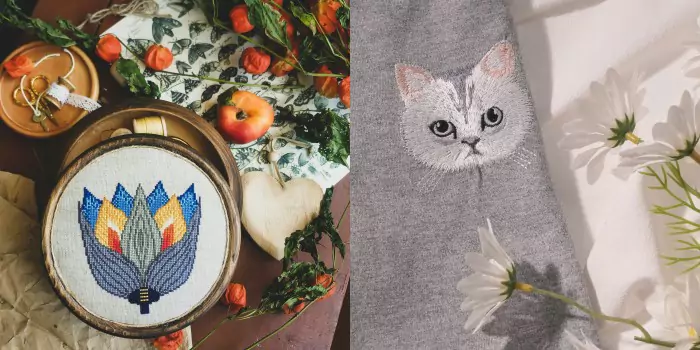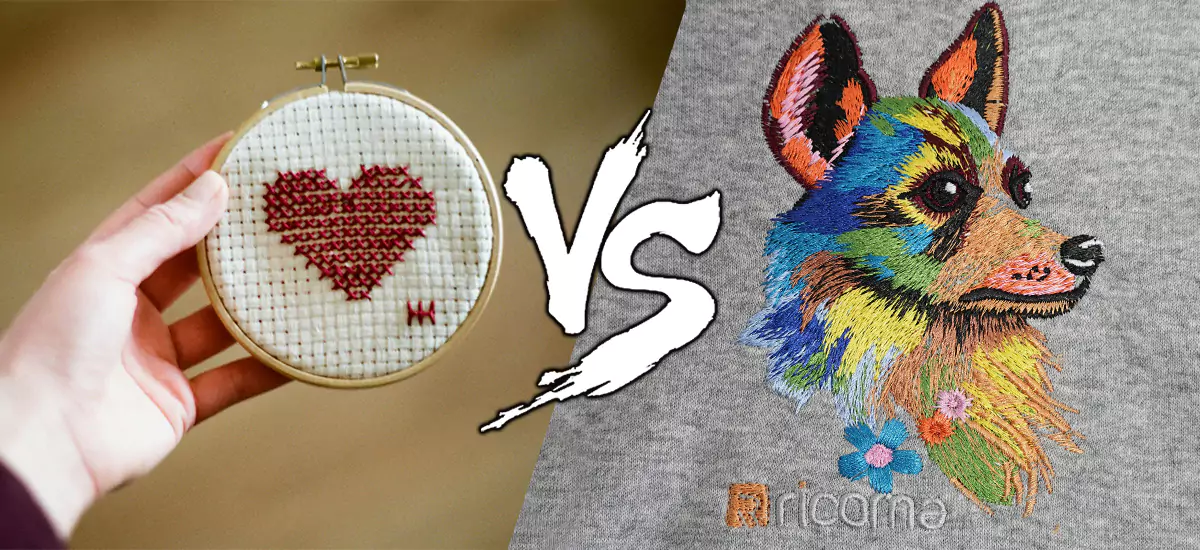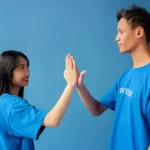Do you know?
- Both Embroidery Vs Cross Stitch are sorts of fiber crafts, however with different methods and designs.
- Fabric like Aida cloth one uses an embroidery hoop with a tapestry needle when doing cross-stitching but various fabrics are used in conjunction with sharp needles during embroidering.
Deciding between these two crafts( Embroidery Vs Cross Stitch) can seem confusing at first glance – but fear not, we’ll help you pick the perfect path.
Key Differences Between Embroidery Vs Cross Stitch
1. Stitching Technique
In cross stitch, a decorated pattern is formed by making many “X” shaped stitches over a charted design. The vast array of embroidery stitches include satin, chain and French knots that create dimensional textures among others.
2. Pattern Style
Cross stitch patterns provide precise stitch-by-stitch instructions to re-create a pre-set image. Embroidery patterns are more freeform, allowing for creative interpretation.
3. Color Technique
In cross stitch, colors don’t blend – the design emerges from placement of distinctive stitched blocks. Embroidery allows for shading and smooth color transitions.
4. Equipment
Cross stitch uses an embroidery hoop and blunt tapestry needle. Embroidery requires a sharp hand-sewing needle.
5. Dimensionality
Cross stitches lay flat on the fabric surface. Many embroidery stitches create raised, dimensional textures.
6. Learning Curve
The repetitive, counted cross stitch makes it more accessible for beginners. Embroidery’s wealth of stitches presents a higher initial learning curve.

Techniques and Styles of Embroidery Vs Cross Stitch
Cross Stitch Techniques
- Half-stitch: This technique involves making a single diagonal stitch that fills one square on the fabric grid. It’s like drawing a line from one corner to the opposite corner within a single box.
- Back-stitch: Imagine using a needle and thread to draw simple straight lines on fabric. That’s what back-stitch is all about. It’s often used for outlining shapes or adding tiny details to a design.
- Fractional stitches: Sometimes, you might want to blend colors smoothly or create a gradual transition. Fractional stitches let you do that by using just a part of the complete “X” stitch. It’s like coloring in a square partially with one color and the remaining portion with another.
Embroidery Techniques
- Satin stitch: Imagine a flat, smooth area on the fabric where the thread stitches lie next to each other, like blades of grass growing close together in a field. This stitch creates a solid, even section of color.
- Chain stitch: Picture a line made up of tiny loops linked one after the other, forming a chain-like pattern on the fabric. This decorative stitch is often used for outlining or adding pretty details.
- French knot: Try tying a tiny knot directly on the fabric’s surface, creating a little raised bundle. This knot stitch adds texture and dimension, making your embroidery more interesting.
- Stem/outline stitches: Think of using your needle and thread to draw lines on the fabric. These stitches follow a path, helping you create borders, outlines, or define the shapes within your embroidery design.
Projects of Embroidery Vs Cross Stitch
Cross Stitch Projects
- Samplers: Alphabets, borders, and motif designs
- Pixel art: Replicating video game graphics or characters
- Home decor: Framed pictures, pillows, bookmarks
- Wearables: Cross stitched jewelry, patches, accessories
Embroidery Projects
- Embellishing garments and accessories like denim jackets, hats, bags
- Mixed media art: Combining embroidery with other techniques like painting
- Embroidered portraits or landscapes utilizing shading
- Three-dimensional pieces using raised embroidered textures

Tools and Supplies
For Cross Stitch
- Aida or evenweave fabric
- Embroidery hoop
- Tapestry needles
- Embroidery floss
- Printed cross stitch pattern
For Embroidery
- Cotton, linen or other fabric
- Embroidery hoop
- Crewel/sharp embroidery needles
- Embroidery floss, pearl cotton, ribbon, wool threads
- Fabric transfers, traceable patterns or drawings
Choosing Between Embroidery Vs Cross Stitch
Cross stitch may be preferable if you
- Are a beginner exploring fiber arts
- Prefer following set patterns
- Want a lower-stress, meditative handicraft
- Aim for precise, pixel or geometric designs
Embroidery may be better if you
- Have some fiber arts experience
- Crave creative freedom and experimentation
- Enjoy hands-on artistic challenges
- Want highly textured, dimensional artworks
Key Takeaways
- Cross stitch is done by creating a simple “X” stitched pattern over and over again, while embroidery uses many different complex stitches.
- It may be generally considered that cross-stitching is easier for beginners to pick up whereas embroidering offers greater freedom in terms of creative expression;
- Tools differ, with cross stitch using an embroidery hoop and tapestry needle on even-weave fabric; embroidery uses a variety of fabrics and sharp needles
- The preferred craft depends on personal goals – cross stitch for structured patterns or embroidery for freeform artistic expression
The Final words
Both Embroidery Vs Cross Stitch nurture creativity, focus and achievement. Make your choice based on preferred techniques, learning goals and the artistic satisfaction you hope to gain from this rewarding fiber art.
For more Embroidery and Gift related content, we invite you to explore the diverse range of articles available on mystichot blog. Discover a wealth of resources that will fuel your passion and help you unlock your creative potential.





